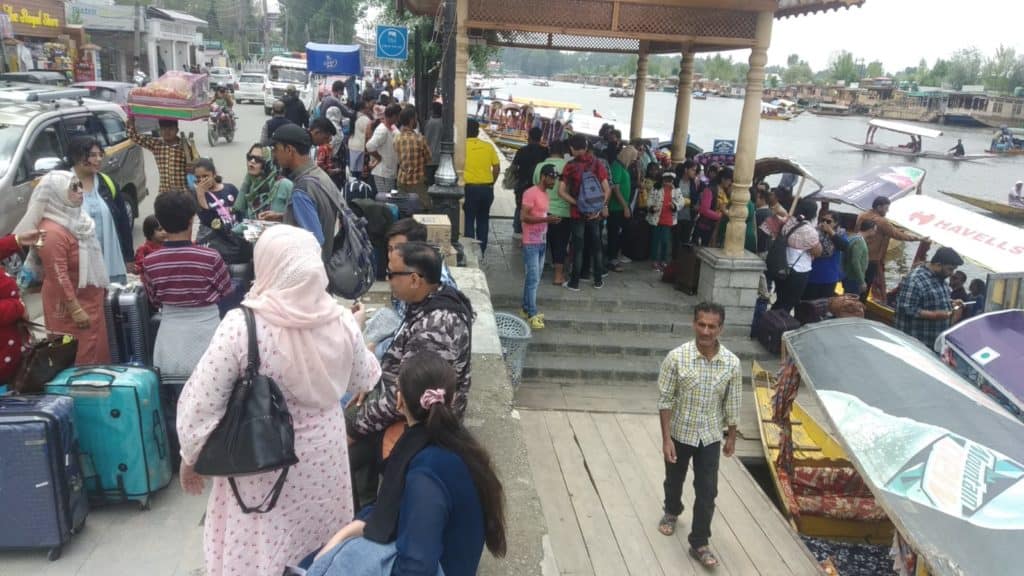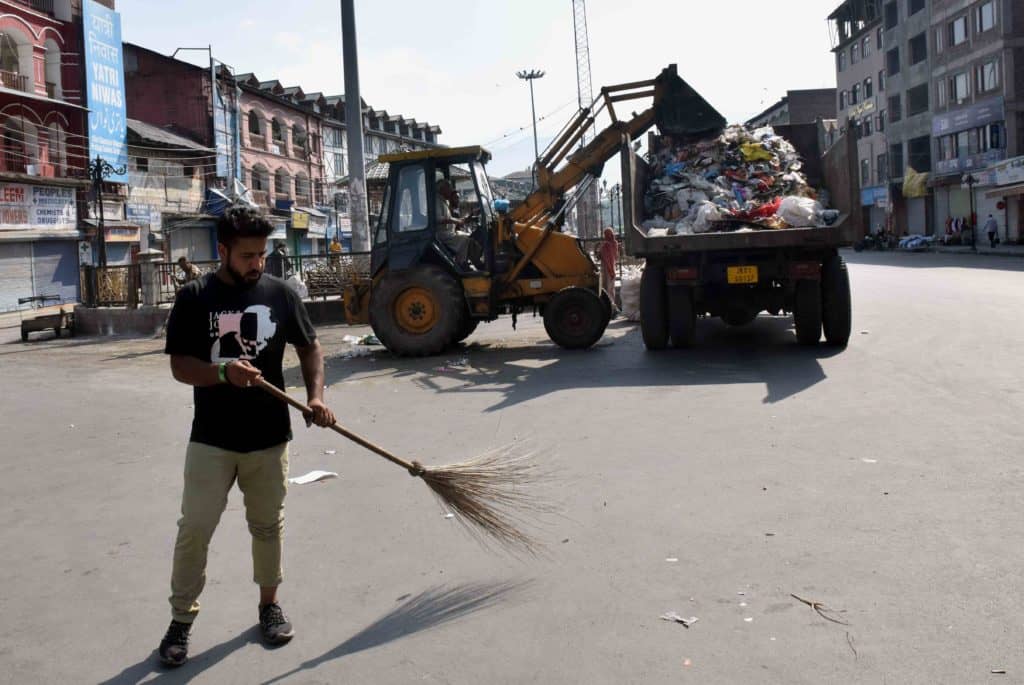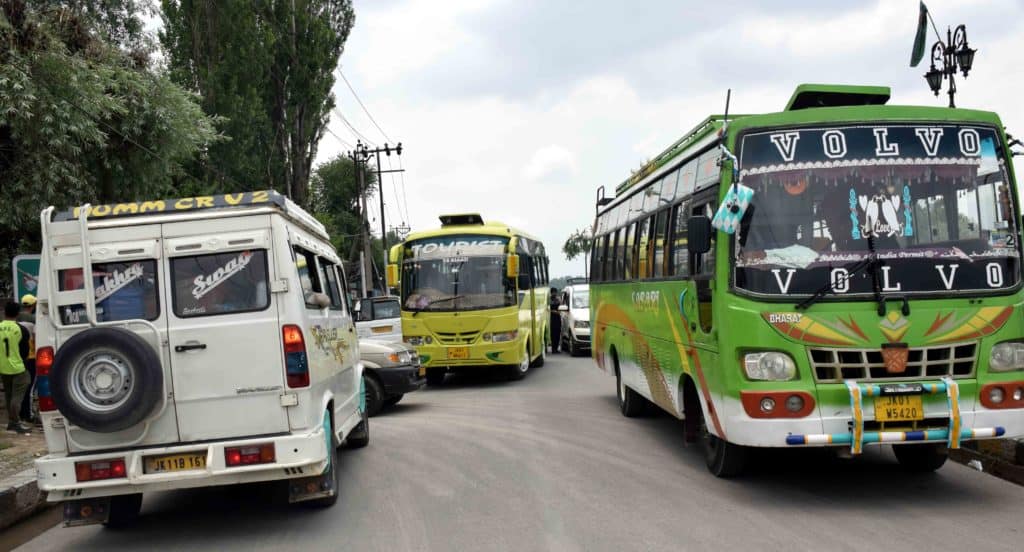After suffering badly for two consecutive years (2020-2021) due to COVID, Jammu and Kashmir’s ailing tourism sector is back on track with a bang. In January this year, the state’s tourism department launched a major promotion plan highlighting places other than the usual tourist spots like Gulmarg. The promotion seems to have worked, if one looks at the steady arrival of tourists in Srinagar.
The plan entailed holding road shows in Gujarat, Bhubaneshwar, Bengaluru, Kolkata, Maharashtra and other states inviting tourists to Kashmir. The results have been more than satisfactory. Srinagar has been jam-packed with tourists since March and guests are finding it difficult to get hotel accommodations.
Government figures suggest that since January this year, seven lakh tourists visited Kashmir for the first time in the past decade. Srinagar’s streets, gardens, houseboats, hotels, lodges and guest houses are not just full with tourists but most have advance bookings till August.
Read more: Tourists continue to arrive amid big COVID surge and total lockdown in Srinagar
On the verge of closure barely a year back, today the 1200 houseboats in Srinagar’s Dal lake and Nigeen Lake are packed with tourists and have advance bookings till September. “We have been bearing the brunt of turmoil for over the past three decades,” said Ghulam Muhammad, a houseboat owner in Dal Lake. “For two consecutive years—2020 and 2021, there were hardly any tourists in Srinagar. But thanks to Almighty, we are recovering well this year”.
And many are first time visitors. “Whatever is being spread about Kashmir on media is totally wrong,” said Sakshi Sharma, a housewife. “We have come here for the first time. People here are nice. We are staying in a houseboat that has four rooms and all are booked. Wherever we go, we meet tourists from Delhi, Gujarat, Hyderabad, Lucknow, Mumbai, Rajasthan and other parts of India.”
A group of tourists from Pune were seen capturing pictures at Srinagar’s famous Mughal garden. Some were enjoying the fountains while few were singing yesteryear’s famous Bollywood song —‘Ye wadiyey Kashmir hai, Janat Ka nazara’ (This is Kashmir valley, the real paradise).

The downside
But while the tourism department is no doubt happy, the Srinagar city administration including Srinagar Municipal Corporation (SMC) and the police traffic department are facing major challenges in dealing with the huge amounts of food and other waste being discarded haphazardly by visitors, and the traffic congestion on the roads.
Read more: How Srinagar’s historic hub is losing its centuries-old glory
Srinagar is the first point of contact for every tourist who visits Kashmir either by air or road. They all stay a day or two in Srinagar before heading out to other well-known destinations like Pahalgam, Gulmarg, Sonmarg.
As per figures available with the tourism department, March broke all previous records with 1.8 lakh tourist arrivals. “This is the first time in the past ten years that such a huge number of tourists have visited Kashmir,” said Dr G N Itoo, Director Tourism Kashmir.
While no doubt the tourism segment and Srinagar’s economy is getting a much-needed boost, the J&K administration as a whole is ill-equipped and ill-prepared to deal with the challenge of accommodating such a large number of tourists, managing the resultant waste disposal and the bumper to bumper traffic on the state’s roads.

Officials at the Srinagar Municipal Corporation (SMC) said that a total of 450 metric tons of waste is generated in Srinagar per day. “The city produces 62% organic waste and 7% plastic waste a day,” said one SMC official. “In the wake of huge tourist influx, there has been 15% increase in the organic waste and 20% increase in plastic waste”.
SMC Mayor Junaid Matoo told Citizen Matters that extra manpower has been deployed across Srinagar, especially outside hotels and the Mughal gardens, to collect trash early in the mornings. “We are following scientific means of waste disposal and our staff is following Solid Waste Management programme in spirit,” said Matoo. “Almost 50 extra men have been deployed in Srinagar especially in the tourist zones to ensure cleanliness of areas. SMC teams work during evening hours too to keep the city clean despite the huge tourist influx.” However, there are no specific measures taken by the SMC to deal with plastic waste.
Heightened security at tourist destinations
Police and other security agencies have been working round the clock to ensure Close Circuit Television sets (CCTV) monitoring at all tourist destinations in Srinagar and other destinations. “Tourist movement is being monitored round the clock,” said Inspector General of Police (IGP) Kashmir zone, Vijay Kumar.
“We’ve had no issue with tourist security so far. All measures are in place for their protection. There is deployment of police and other security forces personnel as per the need at tourist destinations”.
However, it needs to be mentioned that militants have not targeted tourists even as they targeted members from the minority community, especially Kashmiri Pandits, working in Kashmir. Non-local labourers and employees are also being targeted, raising security concerns about the annual Amarnath pilgrimage to commence from June 30.
Official figures suggest that in the past five months, there has been 100% increase in vehicular traffic in Srinagar city, which was already facing huge traffic snarls even earlier. The tourist influx has added to the challenge of managing the traffic in the city.
“Managing traffic in Lal Chowk, the city centre, is like hell especially during peak hours — 7 am to 10 am and in evening hours from 6 pm to 10 pm,” said Arshid, a traffic cop, deployed in Lal Chowk. One could see the serpentine queues of vehicles especially those ferrying tourists.
A traffic department official said that this happens as Lal Chowk is the only route for every tourist to reach Dal Lake and its surrounding areas. “Majority of the tourists prefer to stay in houseboats and hotels around the Lake,” said the official. “So every single tourist vehicle has to cross Lal Chowk. On an average two lakh vehicles ferrying tourists ply in Srinagar every day. Roads are same and there are just two fly-overs in the city. You can imagine the situation.”
Read more: How can India move towards more sustainable waste management in tourist cities?
“We have deployed additional men at various crucial junctures that includes Lal Chowk and Boulevard road (alongside Dal lake),” said Senior Superintendent of Police Traffic Srinagar city, Muzafar Ahmed Shah. “Managing traffic these days is indeed a real challenge.”
On the Srinagar-Jammu national highway, the only road that connects Srinagar with the rest of India, there has been 40% increase in vehicular traffic. “It is now taking two to three hours more to reach Srinagar from Jammu” said Senior Superintendent of Police Traffic (National Highway) Shabir Malik.
Keeping the gardens pristine
The many beautiful Mughal gardens at Nishat, Shalimar, Cheshmashi and Harwan are among the main attractions for tourists in Srinagar. In recent weeks, these gardens are packed with tourists. Gardeners and sweepers are working round the clock to keep the gardens clean. Manpower has been increased in all these gardens by the J&K’s Floriculture department responsible for management of gardens.
“I have not been able to go home since past two weeks,” said Fayaz Ahmed, a gardener at Nishat. “I am working round the clock to ensure beauty of the garden remains intact. Earlier, just four people used to be deployed for managing the Nishat garden but given the huge rush of tourists, the number has been increased to 12 that includes five sweepers. Tourists, especially children, throw plastic bottles, chips packet covers into the fountains despite directions written on sign-boards not to do so.
“The major challenge for us is to keep the washrooms clean,” added Fayaz. “Five people clean the two washrooms throughout the day, they hardly get time to even have their lunch. We also have to ensure that nobody cuts or damages the flowers at the garden. I haven’t seen such a surge in tourist numbers in the past 15 years. The waste left by the tourists has become a major issue”.
Environmental concerns
Looking ahead, the tourism department is mulling reviving home stays in Srinagar and other parts of the valley to ease the space crunch. “Home stays had been a major attraction in the early 70s and 80s,” said Secretary J&K Tourism, Sarmad Hafeez. “The Tourism department is also increasing the room capacity at tourist destinations. We are watching the footfall of tourists in Srinagar and elsewhere closely and taking steps accordingly, to accommodate them in collaboration with various developments. We are glad to see that hotels which had shut down after facing huge losses are re-opening. We are providing them all help to revive their business”.
Meanwhile, environmentalists have urged the government to restrict entry to gardens, lakes, and other tourist places to protect the beauty, flora and fauna of these areas. “Tourists are welcome but we need to protect our beauty,” said Saleem Javaid, an environmentalist in Srinagar. “The government needs to ensure strict adherence to the guidelines. Complaints have been pouring in from various parts of Srinagar including Dal Lake that tourists throw food waste, bottles and chips-covers into the lake. This should be stopped and those indulging in this should be fined.”

Opening up new areas to tourists
A newly-married couple from Maharastra was taken to a new tourist destination of Kashmir which was not on the tourist circuit all these years. They travelled to Drang in Tangmarg area of Baramulla where they fell in love with the breath-taking waterfall and the scenery.
“We travelled to Gulmag, Pahalgam and all Mughal gardens in Srinagar but Drang is the most beautiful among the lot,” said Nikita and her husband Rohanpreet.
Such tours are part of the tourism department’s efforts to open up new areas in the valley to tourists besides the usual Srinagar, Gulmarg, Pahalgam circuit. The new sites even include visits to villages on the border with Pakistan in Uri, Karnah, Keran and Teetwal areas of north Kashmir in the wake of the ceasefire agreement between Indian and Pakistani armies in February last year.
Imtiyaz Ahmed, a local cab driver, took a group of tourists to the border area of Keran and Tangdhar in north Kashmir’s Kupwara district. Border residents host the tourists at their homes.
“The group (of tourists) enjoyed it a lot, the experience of life in the border villages of north Kashmir,” said Imtiyaz in a call with Citizen Matters from Tanghdar.
The plan to promote new tourist destinations was taken at a meeting on June 2nd chaired by Chief Secretary Arun Kumar Mehta. “We are working on a plan to explore and promote 75 new tourist destinations with a three-month tourism festival to be held from November to January,” said Arun Mehta.
The new sites include Tosamaidan and Dodhpatri in Budgam, Gurez in Bandipora, Drang in Baramulla district and Karnah, Keran and Teetwal area of north Kashmir
The activities will include, trekking and mountain bike adventures.